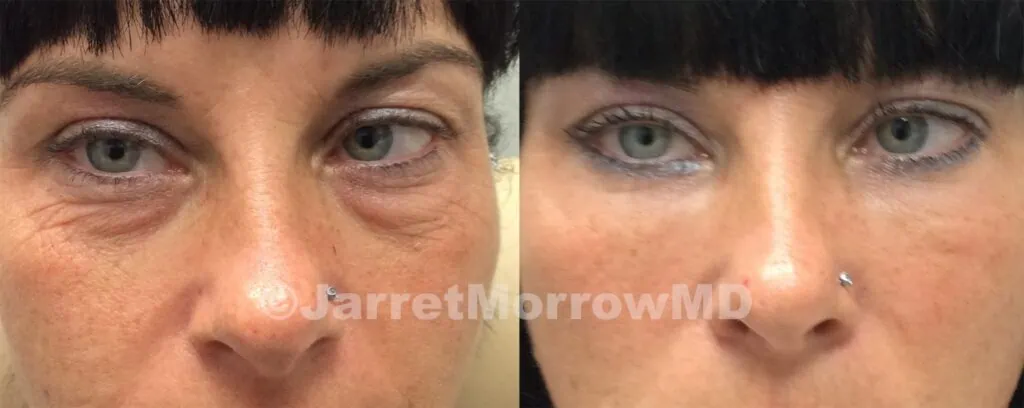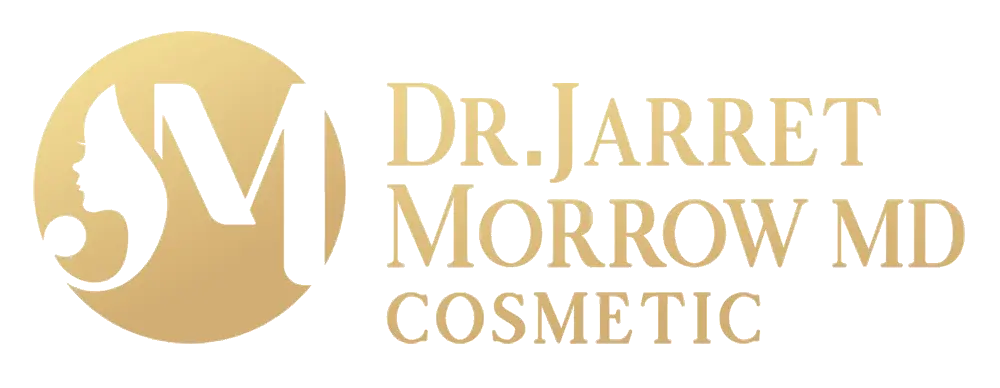Dark circles, under-eye bags, or skin laxity can create a fatigued appearance—even when you’re well-rested. Book a free consultation with expert cosmetic physician Dr. Jarret Morrow, MD, in Langford to find out if under-eye correction with dermal fillers is the right treatment option for you.
Eye Filler – Dark Circle Correction Victoria
The tear trough, or nasojugal groove (located below), are lines that extend from the inner part of your eyelid towards the cheek. As we age, we experience a natural loss of fatty tissue and consequently volume around the lower eyelid and upper cheek area, causing the tear troughs to become either dented or puffy. As the fatty tissue under your eyes pushes outward, you might start to notice under-eye bags, dark shadows, and creases.
If expensive eye creams, serums, and masks aren’t doing anything to fix your under-eye bags, under-eye filler (also called “tear trough filler” or “dermal filler”) might be your best option. Under-eye filler, an injectable treatment, can help level out creases and restore volume to your under-eye area, resulting in smoother, fuller skin. Essentially, the ‘lid cheek junction’ is continuous when we’re younger, but becomes more discernable with age.
Whether you’re looking to combat the signs of aging or look less tired, finding a reputable doctor is the first step. Although the results of your dermal filler will be subtle, they can make all the difference in your overall appearance. If you’re considering booking an appointment, here’s what you need to know about dermal filler before going under the needle.
When Dermal Filler Works—And When It Doesn’t
Most clients who come to our office for dermal filler share the same goal: to get rid of under-eye creases so they can stop looking chronically tired. Dermal filler is ideal for treating under-eye bags (also called the pseudoherniation of orbital fat)¹, but it can also help treat volume loss under the eyes.
The goal of tear trough filler is to reduce the depth of your tear trough—the crease between your lower eyelid and upper cheek. While some individuals inherit deeper tear troughs, others notice their tear troughs as they become older, as age leads to the loss of volume, decreased collagen production, and reduced skin elasticity².
Sometimes, deep tear troughs can cast unflattering shadows below your eyes, making you look tired—even after you’ve had a full night’s sleep. Some of our clients also believe that their under-eye bags make them look older. Tear trough fillers help smooth out these imperfections by making the skin look smoother, tighter, and rejuvenated.
Unfortunately, dermal filler is not a treatment for skin pigmentation. If your dark circles are caused by darker pigmentation around your under-eye area, filler may only accentuate these pigments. To determine whether your under-eye bags are caused by pigmentation, examine the area under bright overhead lighting. If the shadow disappears, your dark circles are caused by tear troughs. If the circles remain, you likely have pigmentation.

*actual patient of Dr. Jarret Morrow. Individual results may vary.
Types of Dermal Filler
The most popular type of dermal filler is hyaluronic acid (HA), a substance naturally produced by the body. HA fillers have natural plumping characteristics and help boost collagen production in the immediate area, resulting in smooth, healthy-looking skin³. Common types of HA tear trough fillers include:
- Juvederm® Volbella, Volift, Voluma, Ultra Plus XC
- Restylane® Refyne, Defyne, Lyft, Volyme, Skin Boosters, Fine lines
- Revanesse® Kiss, Ultra, Contour, and Redexis
Other types of semi-permanent dermal fillers include poly-l-lactic acid (Sculptra), a collagen stimulator, and calcium hydroxyapatite (Radiesse). However, Sculptra and Radiesse are not used for under-eye correction. Some plastic surgeons also perform lower lid blepharoplasty procedures sometimes using fat grafting which involves gathering fat from another area of the body and injecting it beneath the eyes. A lower lid blepharoplasty is the preferred procedure for patients with protruding orbital fat pads.
What To Expect During Your Procedure
During your initial consultation, Dr. Morrow will evaluate your under-eye area to determine whether you’re a good candidate for dermal filler. Then, if you’re a good candidate for under-eye filler, you’ll schedule your in-office appointment.
Dermal filler procedures typically takes approximately 30 minutes.
Here’s what to expect:
- Before the injection, your doctor will disinfect your under-eye area to minimize your risk of infection. Then, they will apply a topical anesthetic or an ice pack to temporarily numb the area and reduce bruising.
- Next, your doctor will prepare a syringe and inject the filler into the skin under your lower eyelid.
- Then, your doctor will slowly remove the cannula. They will gently massage the area to spread the filler and repeat the procedure on the other side.
Dr. Morrow prefers to use microcannula injections instead of sharp needles. By avoiding problem areas such as the glabella (the area between the eyebrows), Dr. Morrow will minimize your risk of adverse side effects.
Under-eye filler uses thinner molecules than the ones used in your cheeks, so you won’t experience the heavier pressure that comes with other types of injections. While it’s normal to feel nervous about having needles so close to your eyes, the injection pain is minimal and only lasts a few seconds.
Because dermal filler is a quick, simple, nonsurgical procedure, there’s no need to take the afternoon off from work. The procedure requires minimal downtime, meaning you won’t have to go home and rest after leaving the doctor’s office. If you’re worried about swelling or bruising, avoid drinking alcohol and taking nonsteroidal anti-inflammatory drugs (NSAIDs) in the days leading up to your appointment.
Fillers typically last between six months and one year, although the duration of your results will depend on individual patient factors.
Are You a Good Candidate for Tear Trough Filler?
If you have under-eye creases or bags, dermal filler for tear trough correction can help you achieve a more youthful look while minimizing the appearance of unflattering shadows. Some signs that you might be a good candidate for dermal filler treatment include:
- You have bags, creases, or sagging under your eyes⁴
- You have thick, healthy skin around your under-eye area
- You have realistic expectations and a positive outlook going into the procedure
- You understand the results of dermal filler treatment are temporary
- You’re in good physical health
Of course, the best way to determine whether you’re a good candidate for tear trough filler is to schedule a consultation with an experienced cosmetic doctor. There’s a steep learning curve to dermal filler, especially considering how delicate the under-eye area is.
So, instead of heading to your local medical spa, it’s essential to schedule an appointment with a board-certified doctor experienced in dermal filler treatment. When you schedule an initial assessment with an experienced doctor, you’ll have the opportunity to discuss your treatment goals, ask any questions you have about the procedure, and determine which type of filler is right for you.
Dr. Jarret Morrow, MD is an experienced cosmetic physician in Geelong at The Cottage Medical Centre in Grovedale. If you’re considering dermal filler treatment for a natural, youthful appearance, book an appointment with Dr. Morrow today for a free consultation.
Contact US for a Free Consult
Dr. Jarret Morrow MD
References:
- Murri, M., et al. February 2018. An Update on Lower Lid Blepharoplasty. National Library of Medicine. https://www.ncbi.nlm.nih.gov/pmc/articles/PMC5330800/
- Anido, J., et al. January 2020. Recommendations for the treatment of tear trough deformity with cross‐linked hyaluronic acid filler. National Library of Medicine. https://www.ncbi.nlm.nih.gov/pmc/articles/PMC7818415/
- American Society for Dermatologic Surgery. Injectable Hyaluronic Acid. https://www.asds.net/skin-experts/skin-treatments/injectables/injectable-hyaluronic-acid
- American Society of Plastic Surgeons. Who is a good candidate for dermal fillers? https://www.plasticsurgery.org/cosmetic-procedures/dermal-fillers/candidates


